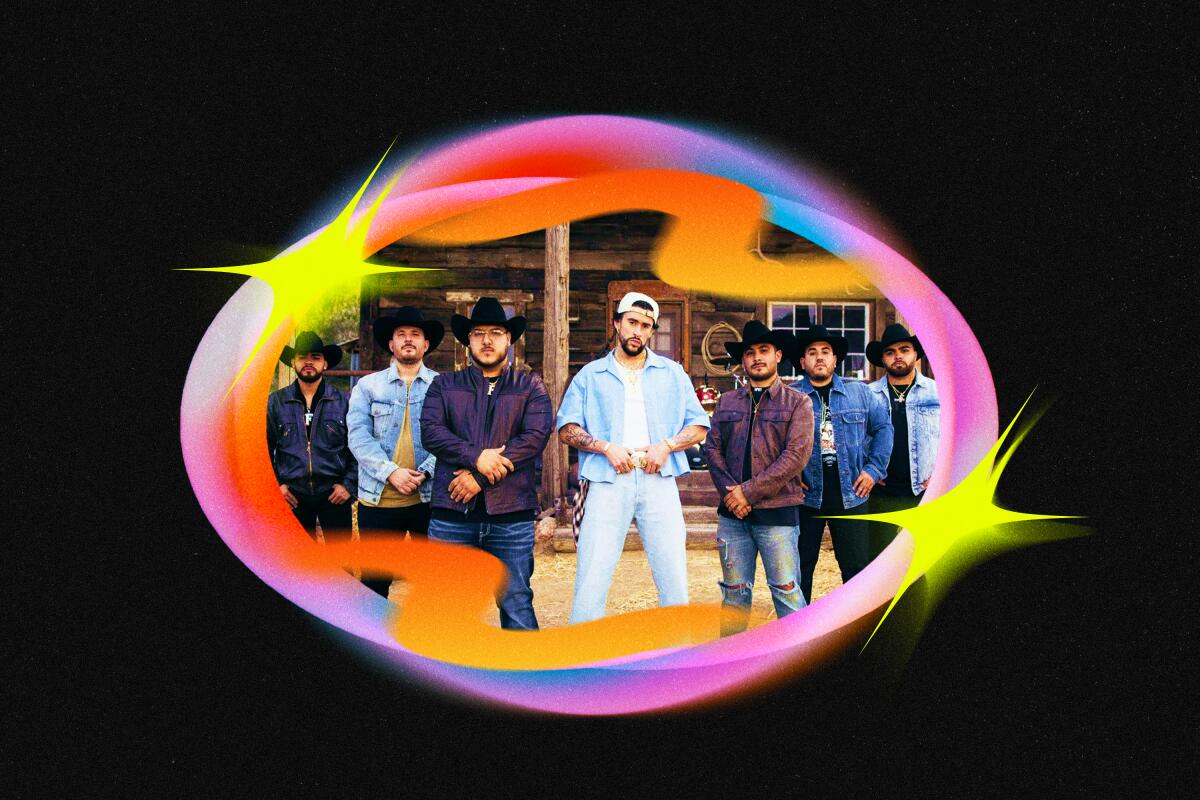How a carne asada changed the lives of Grupo Frontera

- Share via
Welcome to the Latinx Files, a newsletter focusing on the American Latinx experience. Sign up here to get it in your inbox
On Feb. 16, 2022, the members of Grupo Frontera posted their first YouTube video as a band: a live, laid-back cumbia cover of the 2007 mariachi smash “Estos Celos,” as written by Joan Sebastian and performed by Vicente Fernandez.
In the year since Grupo Frontera’s inception, the Rio Grande Valley players have made enormous strides — not just for themselves but for the regional Mexican genre, which is enjoying more fanfare than ever before.
The Latinx experience chronicled
Get the Latinx Files newsletter for stories that capture the multitudes within our communities.
You may occasionally receive promotional content from the Los Angeles Times.
In April, the group made magic with Puerto Rican superstar Bad Bunny, in their joint cumbia jam, “Un x100to” — which the band performed live on the Coachella main stage during the festival’s second weekend. This week, “Un x100to” officially topped the Global 200 Songs chart — the second regional Mexican song ever to do so, after sierreño act Eslabón Armado and the buzzy MC Peso Pluma topped the same chart last week.
Over a post-Coachella Zoom call, the L.A. Times spoke with lead singer Adelaido “Payo” Solís III, percussionist Julián Peña Jr. and accordionist-vocalist Juan Javier Cantú to talk about their rapid ascent.
Made up of six young dudes from the Texas side of the RGV, the band that would become Grupo Frontera first convened in various bars and carne asadas in and around the town of Edinburg. In time, they recruited 19-year-old Solís, whom they discovered singing and playing bajo quinto (a fifth bass) on TikTok.
Grupo Frontera’s output is heavily informed by the cumbia and norteño sounds enjoyed by their elders — many of whom migrated from the neighboring Mexican states of Nuevo León and Tamaulipas. “But we were looking to do something a little different by experimenting with pop and modern sounds,” says Peña.
Grupo Frontera’s first hit was a cover of “No Se Va,” a 2018 hit by Colombian pop band Morat. Upon circulating like wildfire on TikTok, “No Se Va” burned its way into the Billboard Hot 100. Despite having no major label deal nor a studio album to call their own, the band chased this success with two more Hot 100 entries in 2022: “Que Vuelvas” with Carín León, followed by “Bebe Dame” with Fuerza Regida.
“We’re inspired by what we grew up listening to in our trucks — [bands] like Intocable, Duelo, La Firma,” says Solís. “Though our base is cumbia and norteño, at the same time we’re not trying to stick to that older sound — we’re implementing an updated urbanized style, especially in the lyrics, to make something younger generations and the older generations can enjoy.”
The survival of any cultural tradition hinges on its ability to evolve with the community. As young Mexicans on both sides of the border use the internet to seek connection, yesterday’s town squares become today’s TikToks, where dramas take shape and crystallize into folk songs — just as they did for many generations before.
This modernization of culture is central to regional Mexican music’s renaissance among Gen-Z; a growing movement inspired by the late corrido legend Ariel Camacho and advanced to the global music charts by burgeoning young idols like Natanael Cano, DannyLux, and Yahritza y Su Esencia.
Such advancements inspired the guiding premise of the song, “Un x100to,” or a stylized version of “One Percent.”
“When our grandparents were dating, they would send letters; when our parents were dating, they would make phone calls. Now that we’re in a different era, we send text messages,” says Peña. So goes the story of the song: With just 1% [battery] left on his phone, the protagonist uses it to reach out to someone he loved and lost.
The track was written by Grammy-winning songwriter and producer Edgar Barrera: a McAllen, Texas, native who previously penned massive hits for such pop titans as Shakira, Camilo, Maluma and even Madonna; he’s also written many songs for regional Mexican stars like Christian Nodal, Carin Leon and Grupo Firme.
Yet for a man with a larger-than-life repertoire, Barrera’s roots are still as paisa as ever; he encountered Grupo Frontera at the grand opening of his friend’s tire shop outside McAllen, where the band played at a carne asada. Barrera was impressed by the indie group’s rendition of “No Se Va;” not long after, a chance encounter between Barrera and Bad Bunny producer MAG at the recent BMI Awards gave way to the surprise collaboration.
“When we said Bad Bunny would be a dream collab, Edgar told us that was like reaching for the stars,” said Solís. “But on the day we recorded the video, Edgar came up to us and just said ‘OK, we’re gonna do something a little different.’”
The band didn’t know that Bad Bunny recorded a verse for their song until the day they shot the video in a Nevada ghost town — and were shocked to find him emerging stoically from a trailer, a Cowboy Caribeño in the desert. “He started walking up to us in slow motion,” says Solís. Adds Peña, “The dude’s coming up to us like, mean-mugging … and then he’s like, ‘¡Qué pasa MUCHACHOS!’”
“We just talked about trucks and WWE,” explains Solís. “He doesn’t want to be treated like a star; he just wants to be treated like another one of the guys.”
The song “Un x100to” was far from Bad Bunny’s first foray into the regional Mexican multiverse. Benito famously tapped the trap-corrido mixologist Natanael Cano in 2019, for what became a remix of Cano’s original ballad, “Soy El Diablo” — a gritty love letter issued from Puerto Rico to his fellow musicians and fans in Mexico. On the night before his Coachella performance, Bad Bunny asked Grupo Frontera to play a medley of their other hits, “No Se Va” and “Bebe Dame.”
“We just came from the Latin AMAs and were super emotional,” says Solís. “We were nervous that nobody at Coachella would react, because so many different people from so many different cultures were there. But it was amazing to see everybody singing along.”
Grupo Frontera is hard at work on their debut full-length album with Barrera; they’re also in the midst of their “El Comienzo” tour, in which they will pass through the West Coast and the American South. Their next Los Angeles date will be Nov. 25 at the Microsoft Theater.
“What’s essential to playing this type of music is honoring our parents, and their parents, and everyone from the Valley and Northern Mexico,” says Peña. “It’s a big feeling knowing that we can honor everybody who’s been down here.”
— Suzy Exposito
Consider subscribing to the Los Angeles Times
Your support helps us deliver the news that matters most. Become a subscriber.
Texas Gov. Greg Abbott apologies for being wrong ... again.
Late Friday night, five people were killed in Cleveland, Texas, when a man shot his neighbors after they asked him to stop firing rounds in his yard.
The victims, all of whom were Honduran, were identified as Sonia Argentina Guzman, 25; Diana Velazquez Alvarado, 21; Julisa Molina Rivera, 31; Jose Jonathan Casarez, 18; and Daniel Enrique Laso Guzman, 9.
The suspect, Francisco Oropeza, was taken into custody Tuesday afternoon after a days-long search near Conroe, Texas — a city about 20 miles from where authorities last pinpointed the alleged shooter.
Wilson Garcia, a shooting survivor who is the widower of victim Guzman and stepfather of Laso Guzman, shared his harrowing experience of the event with news crews.
“I don’t have the words to describe what happened,” Garcia said. “It’s like we’re alive, but at the same time we’re not.”
Garcia explained that two of the victims, Velazquez Alvarado and Molina Rivera, died protecting two of his young children.
In response to the killings, Texas Gov. Greg Abbott released a statement on Sunday announcing a monetary reward for the capture of the shooter and expressing condolences to the families of the victims. However, Abbott, who has a history of not getting the facts straight with mass shootings, needlessly and incorrectly labeled all five victims as “illegal immigrants.”
It has since been revealed that at least one of the victims, Velazquez Alvarado, was a permanent resident of the United States.
Abbott’s statement was widely and rightfully criticized for emphasizing the immigration status of the victims.
“Five human beings lost their lives and Greg Abbott insists on labeling them ‘illegal immigrants,’” tweeted Julián Castro, the former Housing and Urban Development secretary and San Antonio native.
Actor George Takei expressed disgust with the statement, writing: “This is despicable. I would have thought bringing up the immigration status of the innocent victims of this senseless violence would be beneath even you. But I was wrong.”
“A family is executed and our governor makes sure calling them ‘illegal immigrants’ is at the forefront of his response. Deplorable,” wrote Christian D. Menefee, the county attorney for Texas’ Harris County.
“There is no limit to the depravity of Greg Abbott and his Texas Republican cronies,” Gilberto Hinojosa, chair of the Texas Democratic Party, said in a statement. “To use a mass shooting, in which five innocent souls were slaughtered execution-style — including [a 9 year old] — to fearmonger and lie about migrants and the victims’ immigration status … this type of sick behavior is truly beyond the pale.”
On Monday, Abbott spokesperson Renae Eze issued an “apology” for the governor’s initial statement.
“We’ve since learned that at least one of the victims may have been in the United States legally,” Eze said. “We regret if the information was incorrect and detracted from the important goal of finding and arresting the criminal.”
— Carlos De Loera
The Latinx experience chronicled
Get the Latinx Files newsletter for stories that capture the multitudes within our communities.
You may occasionally receive promotional content from the Los Angeles Times.




